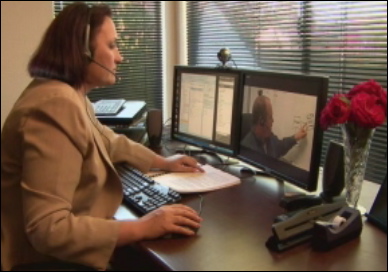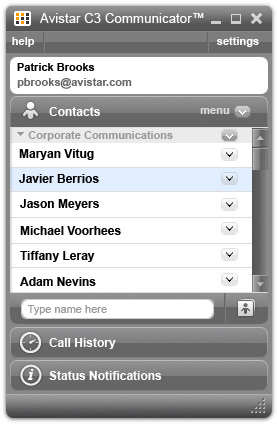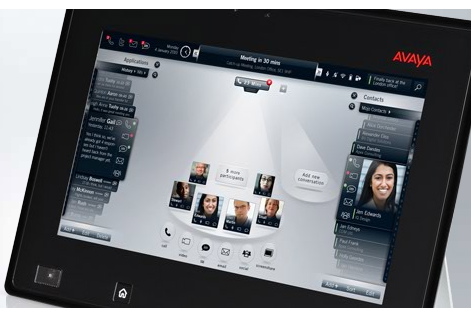![]() Further to my earlier post on the opportunity for PC video communications, the folks at Avistar (among others) reached out to share their views on the role of desktop video in business.
Further to my earlier post on the opportunity for PC video communications, the folks at Avistar (among others) reached out to share their views on the role of desktop video in business.
Avistar Communications, a publicly-traded software company based in San Mateo CA with offices in New York and London UK, was founded in 1993 as a company focused on the desktop video communications opportunity. Of course, in those days, ISDN to the desktop was the only way to reach folks and my employer at the time (Nortel) loved the prospects of stimulating demand for ISDN circuits in the PSTN and of course ISDN off the PBX. Not a particularly pleasant experience for users, IT or telecom managers considering the poor cost-performance of the computers, the cameras available and the small number of accessible users in those days. Black and white video at 10 frames/second cost thousands, consumed LD budget and required substantial infrastructure investment in PBXes to reach any reasonable scale of use. Certainly not a particularly effective alternative to travel.
 Fast forward to 2010 and the modern Avistar product line shows a broad and effective approach to enabling enterprise-scale desktop video communications. The C3 suite involves a client, software-based MCU server, SIP registry, H.323-SIP gateway, systems management and firewall traversal applications. All components are licensed on a per-desktop client basis so customers can get all the infrastructure they need for $399/user (Business Pro Package).
Fast forward to 2010 and the modern Avistar product line shows a broad and effective approach to enabling enterprise-scale desktop video communications. The C3 suite involves a client, software-based MCU server, SIP registry, H.323-SIP gateway, systems management and firewall traversal applications. All components are licensed on a per-desktop client basis so customers can get all the infrastructure they need for $399/user (Business Pro Package).
The Avistar desktop client, C3 Desktop is a pure SIP implementation of a H.264 and G.722 softphone, Windows-only client with Instant Messaging service or plugins to industry-popular IM applications such as IBM Lotus Sametime or Microsoft Office Communicator. The recently announced HD (at 720p) support for Sametime 8.5 shows the company continues to invest in improving the user experience. Smart tags are supported, so the application recognizes telephone numbers and names of IM-supported users enabling a one-click approach that reduces the hurdles in intra-company communications.

 The C3 Communicator is an IM client-server offering for Windows users, that integrates with the C3 Desktop and enables Instant Messaging, VoIP and desktop video.
The C3 Communicator is an IM client-server offering for Windows users, that integrates with the C3 Desktop and enables Instant Messaging, VoIP and desktop video.
The C3 Conference is the Avistar software-based MCU. It enables up to 12 concurrent users in a session and includes support for dozens of conferences (depending on customer-provided server hardware) that could be HD – 30 frames/sec at 720p. Scheduling, remote management and configuration are supported through a web interface. Sessions with voice-switching (imagine a multipoint conference where the speaker is on a larger screen and the other participants are on the smaller screens. Whoever is speaking, pops to the larger screen), or continuous presence (lecture mode) are supported. Sessions are authenticated with passwords. Users are assigned virtual meeting rooms for meet-me ad hoc multipoint conferences. Room-based video systems and all-in audio-only users can participate as well.
The C3 Connect is SIP-H.323 gateway software so customers can integrate their desktop implementation directly into the legacy room-based video conferencing or telepresence infrastructure. The server supports as many as 250 concurrent sessions.
C3 Command is a system-control application that specifies enterprise-wide policies for bandwidth used by classes of users, under network conditions or application.
C3 Tunnel Server is session border controller functionality for enabling inter-company or remote desktop user participation. SIP requires clients to know the actual IP address of each other, which is a big issue in across-the-Internet connectivity since most enterprises use private IP addresses for internal devices. SBCs overcome the problems of NAT (Network Address Translation) in SIP applications without affecting the security advantages of firewalls. The Tunnel Server expands network connections to include other companies and remote users working from home offices or while traveling and certainly facilitates higher utility for the application.
Avistar’s offering is also available for OEM integration (called C3 Media Engine) which they’ve done with Zultys and LifeSize. In Zultys’ case it was about enabling their IP PBX with stronger desktop software and in the case of LifeSize it was about offering their resellers a LifeSize-branded desktop video communications solution.
The current two-tier distribution channel of AV and UC specialists and its OEM relationships work to position this desktop video communications pioneering solution as a leader in desktop video communications. The emergence of USB video cameras capable of HD (720p at 25 fps) for only $99 from Logitech makes the implementation somewhat affordable. The combination of signaling gateways (SIP-H.323) and support for codec standards such as H.264 (C3 Desktop also supports H.263 and H.263+) allows a large-scale desktop implementation to be easily integrated into the room-based operations of most large enterprises. No doubt, as consumer demand for desktop video and even mobile video increases, the feature density of USB and device-imbedded cameras will only increase for a given price. Higher quality for the same dollar price enables more and more desk-bound users a new, reliable and high quality mode of communications.









